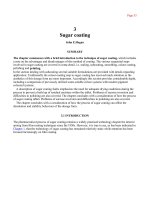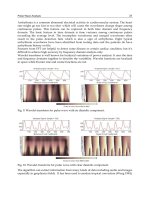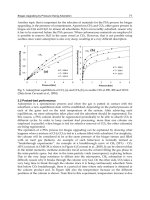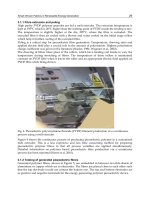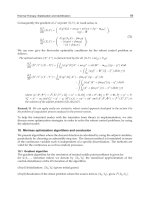A088 advanced concrete technology part 3 processes
Bạn đang xem bản rút gọn của tài liệu. Xem và tải ngay bản đầy đủ của tài liệu tại đây (9.85 MB, 699 trang )
Advanced Concrete Technology
Advanced Concrete Technology
Constituent Materials
ISBN 0 7506 5103 2
Concrete Properties
ISBN 0 7506 5104 0
Processes
ISBN 0 7506 5105 9
Testing and Quality
ISBN 0 7506 5106 7
Advanced Concrete Technology
Processes
Edited by
John Newman
Department of Civil Engineering
Imperial College
London
Ban Seng Choo
School of the Built Environment
Napier University
Edinburgh
AMSTERDAM
PARIS
BOSTON
SAN DIEGO
HEIDELBERG
SAN FRANCISCO
LONDON
NEW YORK
SINGAPORE
SYDNEY
OXFORD
TOKYO
Butterworth-Heinemann
An imprint of Elsevier
Linacre House, Jordan Hill, Oxford OX2 8DP
200 Wheeler Road, Burlington MA 01803
First published 2003
Copyright © 2003, Elsevier Ltd. All rights reserved
No part of this publication may be reproduced in any material
form (including photocopying or storing in any medium by
electronic means and whether or not transiently or incidentally
to some other use of this publication) without the written
permission of the copyright holder except in accordance with the
provisions of the Copyright, Designs and Patents Act 1988 or under
the terms of a licence issued by the Copyright Licensing Agency Ltd,
90 Tottenham Court Road, London, England W1T 4LP. Applications for
the copyright holder’s written permission to reproduce any part
of this publication should be addressed to the publisher
Permissions may be sought directly from Elsevier’s Science and Technology Rights
Department in Oxford, UK: phone: (+44) (0) 1865 843830; fax: (+44) (0) 1865
853333; e-mail: You may also complete your request
on-line via the Elsevier homepage (), by selecting
‘Customer Support’ and then ‘Obtaining Permissions’
British Library Cataloguing in Publication Data
A catalogue record for this book is available from the British Library
Library of Congress Cataloguing in Publication Data
A catalogue record for this book is available from the Library of Congress
ISBN 0 7506 5105 9
For information on all Butterworth-Heinemann
publications visit our website at www.bh.com
Typeset by Replika Press Pvt Ltd, India
Printed and bound in Great Britain
Contents
Preface
List of contributors
xxiii
xxv
Part 1
1
Mix design
Concrete mix design
Joe Dewar
1.1
1.2
Introduction
1/3
1.1.1
1.1.2
1.1.3
1.1.4
1.1.5
1/5
1/5
1/6
1/7
1/8
Interpreting the specification
Selection of materials
Relation between target strength and specified characteristic strength
Useful simplifying assumptions
Interaction between mix design, concrete production and construction
Initial laboratory tests of concrete
1.2.1
1.2.2
1.2.3
1.2.4
1.2.5
1.2.6
1.2.7
1.3
1/3
1/9
Calculations of quantities per cubic metre from initial tests
Adjustments to allow for moisture content of aggregates
Estimation of yield and volume delivered
Estimation of volume of concrete for ordering purposes
Design of an initial test programme
Full-scale tests
Data bank
1/10
1/11
1/11
1/11
1/12
1/12
1/12
Comprehensive mix design of ready-mixed concrete based on
laboratory trials
1/12
1.3.1
1.3.2
1/13
1/16
Use of base data from the BRMCA design method
Mix design example
vi
Contents
1.4
Comprehensive mix design of concrete based on materials properties
1.4.1
1.5
1.6
1.7
Principles and test methods
1/18
MixSim – a computerized comprehensive method of mix design
1/22
1.5.1
1.5.2
1.5.3
1.5.4
1.5.5
1.5.6
1.5.7
1/24
1/24
1/24
1/26
1/27
1/27
1/30
MixSim – key features
Materials database
Mix details
Concrete specification and selected concrete
Trials data
View
Batching data
Special concretes
Simplified mix design methods
1/30
1/31
1.7.1
1.7.2
1/32
1/35
Simplified mix design – the DoE (1988) method
Simplified mix design – the ACI (1991) method
1.8 Ready-to-use mix designs
1.9 Summary
References
Further reading
Part 2
2
2.3
2.4
Special concretes
2/3
Introduction
No-fines concrete (NFC)
2/3
2/4
2.2.1
2.2.2
2/4
2/5
Production
Properties
Aerated and foamed concrete
2/7
2.3.1
2.3.2
2.3.3
2/7
2/7
2/8
Introduction
Production
Properties
Lightweight aggregate concrete
2.4.1
2.4.2
2.4.3
2.4.4
3
1/37
1/38
1/39
1/40
Properties of lightweight concrete
John Newman and Phil Owens
2.1
2.2
1/17
2/9
Introduction
Properties of lightweight aggregate for structural concrete
Properties of structural lightweight aggregate concrete
Experience in use
2/9
2/10
2/11
2/24
References
2/25
High strength concrete
Bill Price
3/1
3.1
3.2
3.3
Aims and objectives
Introduction
Materials technology of HSC
3/1
3/1
3/2
3.3.1
3.3.2
3.3.3
3/2
3/3
3/3
Paste properties
Transition zone properties
Aggregate properties
Contents
3.4
3.5
3.6
4
Materials selection and mix design
3/4
3.4.1
3.4.2
3.4.3
3.4.4
3/4
3/4
3/5
3/6
Cements
Admixtures
Aggregates
Concrete mix design
Properties of HSC
3/7
3.5.1
3.5.2
3/7
3/7
Fresh concrete
Hardened concrete
Production and use of HSC
3/10
3.6.1
3.6.2
3.6.3
3/10
3/11
3/11
Production
Use on-site
Testing
3.7 Examples of use of HSC
3.8 Summary
References
Further reading
3/12
3/14
3/14
3/16
Heat-resisting and refractory concretes
Ron Montgomery
4/1
4.1
4.2
4.3
4.4
4.5
4.6
4.7
4.8
4.9
4.10
4.11
Introduction
Calcium aluminate cement (CAC) versus Portland cement (PC)
Refractory limits of calcium aluminate cements
Refractory and heat-resisting aggregates
Heat-resistant concretes
Insulating concretes
Abrasion and heat-resisting concretes
High-temperature refractory concrete
Low- and ultra-low cement castables
Self-flow castables
Installation of heat-resisting and refractory concretes
4.11.1
4.11.2
4.11.3
4.11.4
4.11.5
4.11.6
Placing and compaction
Curing
Drying and firing
Reinforcement
Shrinkage and thermal expansion
Strength after firing
4/1
4/1
4/2
4/4
4/4
4/6
4/7
4/7
4/8
4/9
4/9
4/9
4/9
4/9
4/10
4/10
4/11
4.12 Applications
4/12
4.12.1 Domestic flues, fireplaces and chimneys
4.12.2 Foundry floors
4.12.3 Fire training areas
5
4/12
4/12
4/13
References
4/13
High-density and radiation-shielding concrete and grout
Eric Miller
5/1
5.1
5.2
5.3
Objectives
Introduction
Uses and applications
vii
5/1
5/1
5/2
viii
Contents
5.3.1
5.3.2
5.4
5.5
5.6
5.7
6
5/2
5/3
Definitions and standards
Aggregates
5/4
5/4
5.5.1
5.5.2
5.5.3
5/5
5/5
5/6
Naturally occurring aggregates
Synthetic or man-made aggregates
General considerations when assessing high-density aggregates
Mix design
Production, transporting and placing
5.7.1
5.7.2
5.7.3
5.8
Nuclear industry
Other uses
5/8
5/9
Production
Transporting, placing and curing
Summary
5/9
5/10
5/11
Concrete properties
5/11
5.8.1
5.8.2
5/11
5/11
Fresh concrete
Hardened concrete
5.9 High-density grouts
5.10 Quality management
5.11 Specifications
5.12 Summary
References
5/12
5/12
5/14
5/14
5/14
Fibre-reinforced concrete
D.J. Hannant
6/1
6.1
6.2
6.3
6.4
6.5
Introduction
Properties of fibres and matrices
Post-cracking composite theory
Theoretical stress–strain curves in uniaxial tension
6/1
6/2
6/2
6/2
6.4.1
6.4.2
6.4.3
6/2
6/4
6/5
Characteristic shapes of stress–strain curves
Critical volume fraction (Vfcrit) in uniaxial tension
Short random fibres which pull out rather than break
Principles of fibre reinforcement in flexure
6/6
6.5.1
6.5.2
6/6
Necessity for theory
Analysis using a rectangular stress block in the tensile
zone of a beam
6/7
6.6
6.7
6.8
Steel fibre concrete
Mix design and composite manufacture
Properties
6/9
6/9
6/11
6.8.1
6.9
Testing
6/12
6/12
6/12
6/12
6.9.1
6.9.2
6.10
6.11
6.12
6.13
Durability
Fresh concrete
Hardened concrete
Applications
Polypropylene fibre-reinforced concrete
Mix design and manufacture
Properties of fresh concrete
6.13.1 Plastic shrinkage cracking
6.14 Properties of hardened concrete
6.14.1 Durability
6/13
6/14
6/15
6/15
6/15
6/16
6/16
Contents
7
6.15 Applications
6.16 Glass fibre-reinforced concrete
References
Further reading
6/16
6/17
6/17
6/17
Masonry mortars
Neil Beningfield
7/1
7.1
7.2
7.3
7.4
7.5
Aims and objectives
Historical background
7/1
7/1
7.2.1
7.2.2
7/1
7/2
The requirements of mortar
7/2
7.3.1
7.3.2
7/2
7/4
7.7
7/5
7.4.1
7.4.2
7/5
7/6
8
The hardened properties
The plastic properties
Constituents of mortar
7/8
Sand
Cement
Lime
Admixtures
7/9
7/12
7/14
7/15
Mortar standards and application documents
7/17
7.6.1
7.6.2
7.6.3
7/17
7/17
7/17
BS 4551 – methods of testing mortars
prEN 998 – The European Standard for mortars
Application documents
Mortar mix design
7.7.1
7.8
7.9
The hardened requirements
The plastic requirements
Properties of mortar
7.5.1
7.5.2
7.5.3
7.5.4
7.6
Ancient mortar
The development of modern cements
7/18
Mix proportions
7/18
Basic masonry design for durability
Site problems
7/19
7/20
7.9.1
7.9.2
7.9.3
7.9.4
7.9.5
7/20
7/20
7/20
7/21
7/21
Incorrect mix proportions
Use of unauthorized admixtures
Sulphate attack
Freeze–thaw cycles
Aesthetic failures
7.10 Summary
References
7/21
7/22
Recycled concrete
Rod Collins
8/1
8.1
8.2
8.3
Introduction
BRE Digest 433 and the properties of recycled aggregate
8/1
8/1
8.2.1
8.2.2
8.2.3
8.2.4
8.2.5
8/2
8/2
8/3
8/3
8/4
General description/classification
Blends with natural aggregate
Impurities
Test methods
Other properties
Methods of recycling and quality
ix
8/5
x
Contents
8.4
8.5
Recipe and performance specifications
8/6
8.4.1
8.4.2
8/6
8/7
Applications – demonstration projects
8.5.1
8.5.2
8.5.3
8.5.4
9
The specification ‘environment’ in the UK before Digest 433
Product specifications
8/7
Concrete blocks
Precast structural concrete
The Environmental Building at BRE
Strong floor at BRE Cardington laboratory
8/7
8/7
8/8
8/10
References
Further reading
8/12
8/13
Self-compacting concrete
Rob Gaimster and Noel Dixon
9/1
9.1
9.2
9.3
Introduction
Materials
9/1
9/2
9.2.1
9.2.2
9.2.3
9/3
9/4
9/4
Mix design
9.3.1
9.3.2
9.3.3
9.3.4
9.3.5
9.3.6
9.3.7
9.3.8
9.4
9.5
9.6
9.7
9.8
9.9
9.10
9.11
Cements and fine fillers
Fine and coarse aggregates
Admixtures
9/6
Influencing factors of SCC mix proportions
Properties of paste and mortar
Coarse aggregate content
Common mix design methods for SCC
Rational mix design method – Okamura and Ozawa (1995)
Linear optimization mix proportioning – Domone et al. (1999)
Model for self-compacting concrete – Petersson et al. (1996)
Solid suspension model mix design – Sedran et al. (1996)
9/6
9/6
9/7
9/7
9/8
9/9
9/10
9/11
Plastic concrete
9/11
9.4.1
9.4.2
9.4.3
9/12
9/12
9/13
Filling ability
Resistance to segregation
Passing ability
Hardened concrete
9/14
9.5.1
9.5.2
9/14
9/15
Compressive strength
Frost resistance
Production and transportation
Placement
Formwork
Surface finish
Mix design optimization – moving SCC to mainstream construction
SCC applications
9/15
9/15
9/16
9/16
9/18
9/19
9.11.1 City environments
9.11.2 Precast
9/19
9/20
References
Further reading
9/20
9/22
Contents
Part 3
Special processes and technology for particular
types of structure
10 Sprayed concrete
Graham Taylor
10.1
10.2
10.3
10.4
xi
10/3
Introduction
History
Definition of sprayed concrete
The wet process
10/3
10/3
10/4
10/5
10.4.1 Definition
10.4.2 General
10.4.3 Equipment
10/5
10/6
10/6
10.5 Dry process
10.5.1 Definition
10.5.2 General
10.5.3 Equipment
10.6 Constituent materials
10.6.1
10.6.2
10.6.3
10.6.4
10.6.5
10.6.6
Cement
Aggregates
Mixing water
Admixtures
Fibres
Cementitious additions
10.7 Spraying procedures
10.8 Quality assurance
10.8.1 Introduction
10.8.2 Prequalification of nozzlemen
10.9 Quality control
10.9.1
10.9.2
10.9.3
10.9.4
10.9.5
10.9.6
10.9.7
Drawing review
Potential debonding and delamination
Tensile bond strength
Strength and density
In-situ testing
Daily test panels
Conclusion
10.10 Applications of sprayed concrete
10.10.1 New construction
10.10.2 Free-formed structures
10.10.3 Strengthening and repair
10.10.4 Protective coatings
Further reading
11 Underwater concrete
Graham Taylor
11.1 Introduction
11.2 Conventional methods of placing
11.2.1 Tremie
11.2.2 Hydrovalve
11.2.3 Skips
10/6
10/6
10/7
10/8
10/8
10/9
10/9
10/9
10/9
10/9
10/10
10/10
10/11
10/11
10/12
10/12
10/12
10/12
10/12
10/13
10/13
10/13
10/14
10/14
10/14
10/16
10/16
10/17
10/18
11/1
11/1
11/1
11/1
11/3
11/4
xii
Contents
11.2.4
11.2.5
11.2.6
11.2.7
11.2.8
Pumps
Toggle bags
Bagwork
Concrete packaged under water
Grouted aggregates
11.3 Concrete properties
11.3.1
11.3.2
11.3.3
11.3.4
11.3.5
11.3.6
Basic requirements
Cementitious materials
Aggregates
Admixtures
Strength
Workability
11.4 Non-dispersible concrete
11.4.1 The admixtures
11.4.2 Concrete handling
11.4.3 Testing
11/4
11/5
11/5
11/5
11/5
11/7
11/7
11/7
11/7
11/8
11/8
11/8
11/9
11/9
11/9
11/10
11.5 Formwork
11.6 Reinforcement
11.7 Conclusion
Further reading
11/11
11/11
11/12
11/12
12 Grouts and grouting
S.A. Jefferis
12/1
12.1
12.2
12.3
12.4
12.5
Introduction
Health and safety
The void to be grouted
Grouting theory and standards
Cement grouts
12/1
12/2
12/2
12/3
12/3
12.5.1
12.5.2
12.5.3
12.5.4
12/4
12/5
12/6
12/7
Cementitious grout materials
Mix proportions
Heat release
Grout mixing
12.6 Cementitious grout testing concepts
12.7 Grout properties
12.7.1
12.7.2
12.7.3
12.7.4
12.7.5
12.7.6
12.7.7
12.7.8
Flow properties – rheology
Grout penetration
Bleed
Filtration
Combined bleed and filtration
Escape of water
Injectable time
Set time
12.8 Grout injection
12.8.1 Duct grouting
12.9 Volume change
12.9.1 Hydration of Portland cement grouts
12.9.2 Drying shrinkage
12.10 The hardened state of cementitious grouts
12.11 Durability
12.12 Chemical grout systems – materials issues
12/7
12/10
12/10
12/16
12/18
12/22
12/22
12/23
12/24
12/25
12/25
12/27
12/29
12/29
12/32
12/32
12/33
12/33
Contents
12.12.1 Fluid properties
12.12.2 Setting
12.12.3 Measurement of set time
12.12.4 Injectable time
12.12.5 Injected quantity
12.12.6 Geotechnical grout penetration
12/34
12/35
12/35
12/35
12/36
12/36
12.13 Volume change in chemical grouts
12/37
12.13.1 Drying shrinkage
12.14 The hardened state for chemical grouts
12.14.1 Strength
12.14.2 Permeability
12.14.3 Durability
12.15 Chemical and geotechnical grout materials
12.15.1 Active clays
12.15.2 Cement grouts
12.15.3 Clay – cement grouts
12.15.4 Microfine cement grouts
12.15.5 Chemical grouts
12.16 Conclusions
References
13 Concreting large-volume (mass) pours
Phil Bamforth
13.1 Introduction
13.1.1 Definition of a mass pour
13.1.2 Benefits
13.1.3 Technical considerations
13.2 The designer’s role
13.2.1
13.2.2
13.2.3
13.2.4
13.2.5
13.2.6
13.2.7
13.2.8
13.2.9
Approaches to the specification
Response to contractors’ proposals
Early age thermal cracking
Limitation of cracking
Performance of construction joints
Materials specification
Testing for conformance
Specification for monitoring of temperatures
Action in event of non-conformance
13.3 Planning
13.3.1 Capability
13.3.2 Planning meeting
13.3.3 Plant
13.3.4 Labour
13.3.5 Material supply
13.3.6 Access
13.3.7 Timing
13.3.8 Quality assurance
13.3.9 Monitoring
13.3.10 Contingency plan for loss of concrete supply
13.3.11 Responsibilities
13.4 Concrete mix design
xiii
12/39
12/39
12/40
12/40
12/41
12/41
12/42
12/42
12/42
12/43
12/43
12/45
12/45
13/1
13/1
13/1
13/2
13/2
13/3
13/3
13/4
13/4
13/5
13/9
13/10
13/10
13/11
13/12
13/13
13/14
13/14
13/14
13/15
13/16
13/16
13/16
13/17
13/17
13/18
13/18
13/19
xiv
Contents
13.4.1 Properties to be considered
13.4.2 Factors influencing key properties
13.4.3 Early age thermal cracking
13/20
13/21
13/26
13.5 Construction of large-volume pours
13.5.1
13.5.2
13.5.3
13.5.4
13.5.5
13.5.6
13.5.7
13.5.8
13/33
Reinforcement design and detailing
Formwork
Construction procedure to minimize restraints
Placing methods
Compaction
Finishing
Thermal control
Monitoring and actions in the event of non-compliance
13/33
13/33
13/33
13/35
13/36
13/37
13/37
13/42
13.6 Review
References
13/44
13/45
14 Slipform
Reg Horne
14/1
14.1 Vertical slipforming
14/1
14.1.1 Types of structure suitable for slipform construction
14.1.2 Standard equipment
14.1.3 Tapering equipment
14.2 Design of the slipform
14.2.1 Standard system operations
14.3 Concrete mix
14.3.1 Performance and development
14.3.2 Mix design
14.3.3 Cement
14.3.4 Aggregates
14.3.5 Admixtures
14.3.6 Distribution on the slipform rig
14.3.7 Vibration
14.3.8 Curing
14.3.9 Methods of concrete distribution
14.3.10 Problems that may arise with slipforming
14.3.11 Remedial action
14.3.12 Slipform mixes – examples
14.3.13 Operations in varying temperatures
14.3.14 Hot weather concreting
14.3.15 Cold weather concreting
14.3.16 Catering for horizontal connections and openings
14.3.17 Connections for concrete
14.3.18 Connections for steelwork
14.3.19 Example of slipformed project
14.3.20 Dayshift-only sliding
14.3.21 Conclusions
14.4 Horizontal slipforming
14.4.1
14.4.2
14.4.3
14.4.4
Paving
Kerbing
Concrete mix
Vibration
14/1
14/2
14/4
14/6
14/6
14/7
14/7
14/9
14/9
14/9
14/10
14/10
14/12
14/12
14/13
14/14
14/15
14/17
14/17
14/18
14/18
14/18
14/19
14/19
14/20
14/20
14/21
14/21
14/22
14/23
14/23
14/24
Contents
15 Pumped concrete
Tony Binns
15.1
15.2
15.3
15.4
15.5
15/1
Liquids
Suspensions
Rheology
Pressure gradients
Types of concrete pump
15.5.1
15.5.2
15.5.3
15.5.4
15.5.5
15.5.6
15.5.7
15.5.8
15/1
15/2
15/4
15/6
15/7
General description
Reciprocating piston pumps
Peristaltic pumps
Static pumps
Mobile pumps
Satellite booms
Pneumatic placers
Condition of pumping equipment
15/7
15/8
15/8
15/10
15/11
15/12
15/13
15/13
15.6 Requirements of a concrete for pumping
15.6.1
15.6.2
15.6.3
15.6.4
15/13
Segregation pressure
Consistence class
Controlled bleeding
Factors that control bleeding
15/14
15/14
15/15
15/15
15.7 Effects of aggregates, cement and admixtures on the
pumpability of concrete
15.7.1
15.7.2
15.7.3
15.7.4
15/17
Cement types
Aggregates
Admixtures
Batching and mixing of materials
15/17
15/18
15/20
15/22
15.8 Modifications to the concrete mix design to ensure pumpability
15.9 Void content of aggregate and procedures for measuring void
content in combined aggregate grading
15.10 Suitable combinations of aggregates for pumpable concrete
15.10.1 Suitable gradings
16.3 Constituent materials
16.3.1 Use of ground granulated blastfurnace slag
16.3.2 Use of limestone aggregates
16.3.3 Aqueous leaching of metals
16.4 Cracking and autogenous healing
15/23
15/26
15/29
15/30
15/31
15/32
16 Concrete construction for liquid-retaining structures
Tony Threlfall
16.2.1 Concrete grades
16.2.2 Maximum cement content
16.2.3 Concrete cover
15/22
15/26
15.11 Recognizing pumpable concrete
15.12 Pressure bleed test apparatus
15.13 Conclusion
References
16.1 Introduction
16.2 Permeability and durability
xv
16/1
16/1
16/2
16/2
16/2
16/3
16/3
16/3
16/4
16/4
16/5
xvi
Contents
16.4.1 Design crack width
16/6
16.5 Cracking due to temperature and moisture effects
16/7
16.5.1
16.5.2
16.5.3
16.5.4
16.5.5
16.5.6
16.5.7
Early thermal cracking
External restraint factors and critical temperature changes
Methods of control
Movement joints
Minimum reinforcement for options 1 and 2
Crack spacing and crack width
Summary of design options and reinforcement
requirements in BS 8007
16.5.8 Crack prediction models in BS 8007 and EC2: Part 3
16/7
16/8
16/10
16/10
16/12
16/13
16/14
16/16
16.6 Workmanship
16.7 Summary
References
16/16
16/17
16/17
17 Coatings
Shaun A. Hurley
17/1
17.1 Introduction
17.2 Reasons for use
17/1
17/2
17.2.1 Summary of uses
17.2.2 The specification of surface coatings/treatments
17.2.3 Additional comments
17/2
17/2
17/5
17.3 Materials for surface coating/treatment
17.4 Surface preparation and application
17/6
17/9
17.4.1 Surface preparation
17.4.2 Application
17.4.3 Quality control
17/10
17/12
17/13
References
Further reading
17/14
17/14
Part 4
Readymixed concrete
18 Production of readymixed concrete
Steve Crompton
18.1 Development of readymixed concrete
18.2 Effects of transportation on concrete properties
18.3 Production methods
18.3.1
18.3.2
18.3.3
18.3.4
18.3.5
18.3.6
References
Constraints on plant design
Types of plant
Weighing systems
Computerization
Environment considerations
Delivery
18/3
18/3
18/4
18/7
18/7
18/10
18/12
18/13
18/13
18/14
18/14
Contents
Part 5
Exposed concrete finishes
19 Weathering of concrete
Frank Hawes and the British Cement Association
19.1
19.2
19.3
19.4
19.5
19.6
Introduction
The inevitability of weathering
Alternative approaches
Weathering on old buildings
The weathering system
Characteristics of concrete
19.6.1
19.6.2
19.6.3
19.6.4
19/3
19/3
19/3
19/5
19/5
19/7
19/8
Properties of concrete surfaces
Performance of concrete surfaces
Biological growth on concrete
Variability
19/9
19/11
19/12
19/12
19.7 External factors
19/13
19.7.1 Climate
19.7.2 Wind and rain on buildings
19.7.3 Air pollution
19/13
19/15
19/15
19.8 The visible effects of weathering
19/20
19.8.1 Rain and dirt on buildings
19.8.2 Movement of water on building facades
19/20
19/21
19.9 Control of weathering
19/25
19.9.1 Prediction
19.9.2 Control
19/25
19/26
References
19/31
Part 6
Formwork
20 Formwork and falsework
P.F. Pallett
20/3
20.1 Introduction
20.2 Definitions
20.3 Formwork
20/3
20/3
20/4
20.3.1 Specifications and finishes
20.3.2 Tolerances
20.3.3 Timber and wood-based products
20.3.4 Release agents
20.3.5 Formwork ties
20.3.6 Proprietary formwork equipment
20.3.7 The pressure of concrete – using a tabular approach
20.3.8 Controlled permeability formwork
20.3.9 Design of wall formwork
20.3.10 Soffit formwork
20.4 Falsework
20.4.1
20.4.2
20.4.3
20.4.4
xvii
General
Contents of BS 5975
Materials used in falsework
Loadings
20/4
20/5
20/5
20/6
20/9
20/10
20/12
20/14
20/14
20/16
20/18
20/18
20/18
20/19
20/19
xviii
Contents
20.4.5 Stability of falsework
20.4.6 Continuity of members
20/20
20/22
20.5 Striking formwork and falsework
20/23
20.5.1 Criteria for striking wall and column formwork
20.5.2 Criteria for striking soffit formwork – beams and slabs
20.5.3 Backpropping slabs in multistorey construction
References
20/24
20/24
20/25
20/26
Part 7
Precast concrete
21 Precast concrete structural elements
John Richardson
21/3
21.1 Summary
21.2 Structural precast concrete
21.3 The advantages to be achieved by employing precast concrete
21.3.1 Advantages of precast concrete in terms of control
and innovation
21.4 Principles of precasting
21.4.1 The construction sequence
21.4.2 Establishing standards
21.4.3 Drawings and controls
21.4.4 Organizing the precast operation
21.4.5 Drawing and documentation control
21.4.6 Design of mouldwork and the way up of casting
21.4.7 Daily make
21.4.8 Mechanical handling
21.4.9 Clear shed principle
21.4.10 Accelerated curing
21.4.11 Condition of stock
21.5 Moulds for precast concrete
21.6 Casting techniques
21.6.1 Concrete supply
21.6.2 Static machines
21.6.3 Mobile casting machines
21.6.4 Casting in individual moulds
21.6.5 Tilting tables
21.6.6 Gang casting
21.6.7 Battery and cell unit casting
21.6.8 Long and short line casting
21.6.9 Post-tensioned beam production
21.6.10 Tilt-up construction
21.6.11 Casting massive elements for civil engineering
21.7 Curing
21.8 Testing and controls
21.9 Frame components
21.9.1 Structural visual components
21.9.2 Flooring
21.9.3 Connections
21/3
21/4
21/4
21/5
21/7
21/7
21/9
21/10
21/10
21/10
21/11
21/12
21/12
21/13
21/13
21/14
21/14
21/15
21/15
21/16
21/16
21/16
21/16
21/17
21/17
21/18
21/19
21/20
21/20
21/21
21/22
21/23
21/23
21/26
21/26
Contents
21.10 Cladding
21/27
21.10.1 Surface finishes
21.10.2 Brick, tile and stone-faced panels
21.10.3 Exposed aggregate, textured and featured finishes
21.10.4 Reconstructed stone
21.10.5 Plain-formed concrete finishes
21.10.6 Size of elements
21.10.7 Joints in cladding
21.10.8 Cladding fixings
21.10.9 Weathering
21/27
21/29
21/30
21/30
21/31
21/31
21/32
21/32
21/32
21.11 Bridge beams
21.12 Double-tee beams
21.13 Sea-defence units
21/33
21/33
21/34
21.13.1 Dollos units
21.13.2 ‘Shed’ units
21.13.3 Walling units
21/34
21/34
21/34
21.14 Piles
21.15 Sleepers
21.16 Structural elements for groundwork and support
21/34
21/35
21/35
21.16.1 Box culverts
21.16.2 Retaining wall units and sound barriers
21.16.3 Tunnel segments
21/35
21/36
21/36
21.17 Erection at site
21/37
21.17.1 Delivery
21.17.2 Handling equipment
21.17.3 Responsibilities
21/37
21/37
21/38
21.18 Segmental casting
21/38
21.18.1 Countercasting
21.18.2 Incremental launching
21/38
21/39
21.19 Troubleshooting precast concrete
21/39
21.19.1 Visual defects
21.19.2 Structural defects
22.19.3 Accuracy of product
21/40
21/41
21/43
21.20 Conclusions
Case studies
References
21/44
21/45
21/46
Part 8
Concrete roads
22 Concrete roads and pavements
Geoffrey Griffiths
22/1
22.1 Introduction
22.2 Typical concrete pavement types
22/1
22/2
22.2.1
22.2.2
22.2.3
22.2.4
xix
Jointed unreinforced concrete pavement (URC) description
Typical applications for URC pavement
Jointed reinforced concrete pavement (JRC) description
Typical applications for JRC pavement
22/2
22/3
22/4
22/5
xx
Contents
22.2.5 Description of continuously reinforced concrete
pavements CRCP
22.2.6 CRCP applications
22/5
22/8
22.3 Manner of pavement failure
22.3.1
22.3.2
22.3.3
22.3.4
22.3.5
22/8
Fatigue cracking of concrete
Loss of support
Frost damage
Surface abrasion
Skidding characteristics
22/8
22/9
22/9
22/10
22/11
22.4 Design methods
22/11
22.4.1 The empirical approach
22.4.2 The semi-empirical approach
22.4.3 Continuous reinforced concrete pavements
22/11
22/12
22/13
22.5 Joint design and detailing
22.5.1
22.5.2
22.5.3
22.5.4
22/14
Transverse contraction joints
Longitudinal joints
Expansion or isolation joints
Typical jointing related problems
22/14
22/14
22/15
22/16
22.6 Materials and concrete properties
22/17
22.6.1 Compressive cube strength and tensile strength relationships
22.6.2 Slip membranes
22.7 Construction methods
22.7.1 Traditional techniques
22.7.2 Slipforming
22.8 Maintenance issues and repair of pavements
22.8.1 Emergency repairs
22.8.2 Medium-term repairs
22.8.3 Long-term repairs
22.9 New techniques
22.9.1 Fibre-reinforced concrete
22.9.2 Thin overlays and white topping
22.10 Conclusions
References
23 Cement-bound materials (CBM)
David York
22/17
22/20
22/20
22/20
22/21
22/21
22/22
22/22
22/23
22/23
22/23
22/23
22/24
22/24
23/1
23.1 Introduction
23/1
23.1.1
23.1.2
23.1.3
23.1.4
23.1.5
23.1.6
23/1
23/2
23/2
23/2
23/3
23/3
Cement-stabilized soil (CSS)
Soil cement (SC)
Cement-bound granular materials (CBGM)
Lean concrete (LC)
Roller-compacted concrete (RCC)
Modes of failure
23.2 Methods of specifying CBM
23.2.1
23.2.2
23.2.3
23.2.4
23.2.5
Compressive or tensile strength
Designing CBM (the mix)
Producing CBM
Laying CBM
Compacting CBM
23/4
23/4
23/5
23/6
23/7
23/9
Contents
23.2.6 Curing CBM
23.2.7 Testing CBM
23/11
23/11
23.3 Summary
References
23/12
23/12
Part 9
Industrial floors
24 Concrete floors
Neil Williamson
24/3
24.1 Introduction
24/3
24.1.1 Floor slab function
24.1.2 Concrete floor slab design and construction: key issues
24.2 Concrete for industrial floors
24/4
24.3 Production issues: consistency
24.4 Floor construction
24/12
24/14
Methods
The finishing process
Planning
Supervision and workmanship
24/14
24/14
24/15
24/16
24.5 Design and loading
24/17
24.5.1 Structural design
24.5.2 Design and workmanship
24/18
24/26
24.6 Floor toppings
24.7 Floor specification
24/30
24/30
24.7.1 Tolerances
24.7.2 Wearing surface performance
24/30
24/32
24.8 Defect identification and remedial measures
24.8.1
24.8.2
24.8.3
24.8.4
24.8.5
24.8.6
24/35
24/35
24/36
24/37
24/37
24/37
Reinforced and prestressed concrete
25 Reinforced and prestressed concrete
Ban Seng Choo
25.1 Objectives
25.2 Principles of limit state design
25.2.1
25.2.2
25.2.3
25.2.4
24/34
Common flooring defects
Joint spalling
Cracks
Delamination
Pop outs
Dusting
Part 10
24/3
24/4
24/4
24.2.1 Mix properties
24.4.1
24.4.2
24.4.3
24.4.4
xxi
Introduction
Permissible stress method
Load factor method
Limit state method
25/3
25/3
25/4
25/4
25/4
25/4
25/4
xxii
Contents
25.3 Structural elements
25.4 Design values
25/6
25/7
25.4.1 Actions
25.4.2 Materials
25.4.3 Partial safety factors
25.5
25.6
25.7
25.8
Load testing of simple structures
Behaviour of reinforced concrete beams
Behaviour of prestressed concrete beams
Summary
References
Part 11
26.1 Aims and objectives
26.2 Other types of reinforcement
26.2.1 Galvanized steel reinforcement
26.2.2 Fusion-bonded epoxy-coated steel reinforcement
26.2.3 Stainless steel reinforcement
26.3 General introduction to fibre composites
27.3.1
26.3.2
26.3.3
26.3.4
26.3.5
26.3.6
Background
Materials
Manufacturing processes
Short-term properties
Long-term properties
Health and safety
26.4 FRP internal reinforcement
26.4.1
26.4.2
26.4.3
26.4.4
26.4.5
Review of materials and manufacturing processes
Advantages and disadvantages
Summary of research
Design guidance
Applications
26.5 FRP prestressing strand
26.5.1
26.5.2
26.5.3
26.5.4
26.5.5
Review of materials and manufacturing processess
Advantages and disadvantages
Summary of research
Design guidance
Applications
26.6 Summary
References
Further reading
25/10
25/10
25/14
25/16
25/16
Alternative reinforcement for concrete
26 Alternative reinforcement for concrete
John L. Clarke
Index
25/7
25/8
25/8
26/3
26/3
26/4
26/4
26/6
26/7
26/8
26/8
26/8
26/9
26/10
26/10
26/11
26/11
26/11
26/12
26/12
26/13
26/15
26/16
26/16
26/17
26/17
26/18
26/19
26/19
26/20
26/21
I/1
Preface
The book is based on the syllabus and learning objectives devised by the Institute of
Concrete Technology for the Advanced Concrete Technology (ACT) course. The first
ACT course was held in 1968 at the Fulmer Grange Training Centre of the Cement and
Concrete Association (now the British Cement Association). Following a re-organization
of the BCA the course was presented at Imperial College London from 1982 to 1986 and
at Nottingham University from 1996 to 2002. With advances in computer-based
communications technology the traditional residential course has now been replaced in
the UK by a web-based distance learning version to focus more on self-learning rather
than teaching and to allow better access for participants outside the UK. This book, as
well as being a reference document in its own right, provides the core material for the
new ACT course and is divided into four volumes covering the following general areas:
• constituent materials
• properties and performance of concrete
• types of concrete and the associated processes, plant and techniques for its use in
construction
• testing and quality control processes.
The aim is to provide readers with an in-depth knowledge of a wide variety of topics
within the field of concrete technology at an advanced level. To this end, the chapters are
written by acknowledged specialists in their fields.
The book has taken a relatively long time to assemble in view of the many authors so
the contents are a snapshot of the world of concrete within this timescale. It is hoped that
the book will be revised at regular intervals to reflect changes in materials, techniques
and standards.
John Newman
Ban Seng Choo
This Page Intentionally Left Blank
